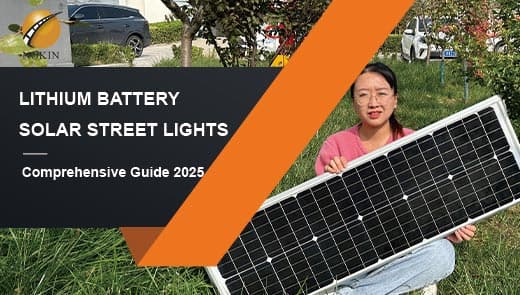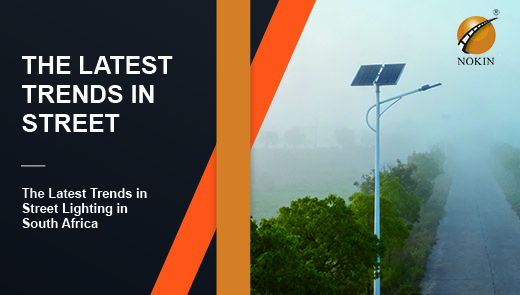Best Solar Street Lights for the Rainy Season
Solar street lights have become the mainstream choice for outdoor lighting thanks to their energy-saving and wiring-free advantages. However, the frequent rainy weather and humid environment during the rainy season puts its performance to a severe test. Continuous rainfall will lead to a sudden drop in the efficiency of solar panels, battery charge/discharge imbalance, and even trigger the internal water and corrosion of the lamps and lanterns. In this article, we will analyze the core challenges faced by solar street lights in the rainy season, and provide scientific selection criteria, product cases and maintenance strategies to help you realize reliable and long-lasting lighting solutions in rainy areas.
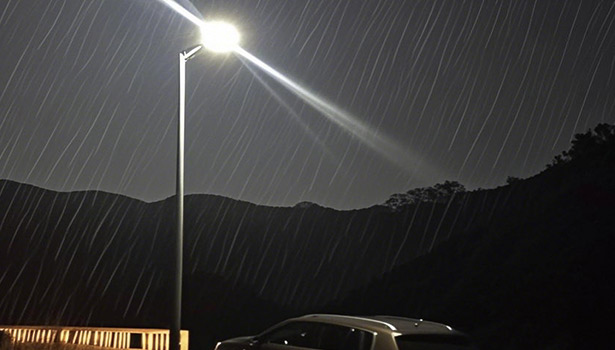
Challenges of Solar Street Lights in Rainy Season
Reduced Solar Power Generation Efficiency
In rainy weather, the intensity of sunlight decreases significantly, which directly leads to a sharp decrease in the power generation of solar panels. Data show that under cloudy or rainy conditions, the actual power generation of solar panels is only 10-30% of that of sunny days. This means that the lamps can not get enough energy to charge the battery in continuous rainy days, especially the system that relies on average daily light, long-term low light will lead to a continuous lack of energy storage, affecting the stability of lighting at night.
Discharge and Charge Imbalance of Batteries
When solar panels are not generating enough power, the battery will be in a state of “undercharging” for a long period of time, and frequent low-power discharges will lead to over-discharging problems. Take lead-acid batteries as an example, long-term over-discharge will lead to plate sulfation, rapid capacity decline, life shortened to less than 50% of the normal working conditions. Even for lithium batteries with longer lifespan, continuous charging and discharging imbalance will affect the stability of its active substance and reduce the number of cycles.
Decreased LED Lamp Working Time
Insufficient battery energy storage directly leads to LED light working time shrinkage. Typical scenarios, normal sunny day can be 12 hours of lighting lamps and lanterns, in the continuous rainy days may only be able to maintain the brightness of 4-6 hours, or even due to the exhaustion of power early extinguished. In addition, the risk of rainwater infiltration is exacerbated: after the aging of the sealing tape of poor-quality lamps, rainwater will penetrate into the interior of the lamp body, resulting in a short circuit circuit of the circuit board or corrosion of the batteries, triggering the failure of the lamps.
IP Ratings and the Meaning of Waterproofing
IP Rating System Explained
IP (Ingress Protection) rating is the authoritative standard for measuring the waterproof and dustproof ability of the lamps and lanterns, consisting of two numbers:
The first digit (0-6): Indicates the dustproof level, the highest level of 6 (completely dustproof);
The second digit (0-9K): Indicates the waterproof level, the larger the number of the waterproof ability of the more powerful.
Comparison of Common Ratings:
|
IP Rating |
Dust Resistance |
Water Resistance |
Typical Application Scenarios |
|
IP65 |
Totally dust resistant |
Resistant to water jets from any direction |
City roads, heavy rain areas |
|
IP66 |
Completely dustproof |
Resistant to strong water jets (e.g. typhoon weather) |
Coastal high humidity areas, mining areas |
|
IP44 |
Resistant to solids ≥ 1mm |
Resistant to splashing (not suitable for sustained rain) |
Garden lighting, balcony lighting |
For rainy areas, IP65 and above ratings are the basic requirement. A high level of waterproofing not only relies on sealing tape, but also requires attention to the luminaire's structural design (e.g., inverted junction, sloped housing to direct water flow). Although poor-quality IP44 lamps can cope with short-term drizzle, long-term exposure to the rainy season is prone to water seepage due to the aging of the adhesive strip, resulting in irreversible damage.
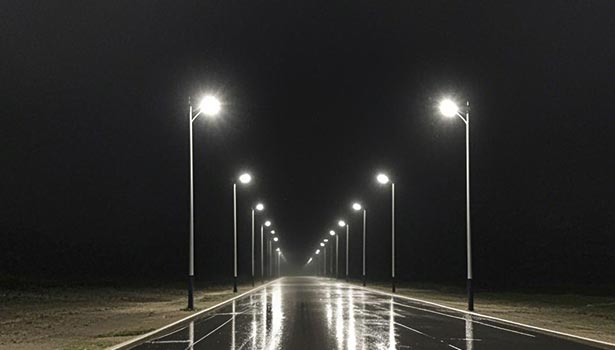
Key Features to Look for in Rain-Proof Solar Lights
Choose Efficient Solar Panels
Choosing monocrystalline or polycrystalline solar panels with conversion efficiencies higher than 20%, paired with anti-reflective coatings or bifacial power generation designs, can capture more scattered light on cloudy days. For example, monocrystalline solar panels can still maintain a power generation efficiency of more than 15% in an environment with a light intensity of only 2,000 lux, which is a 30% increase compared to non-coated panels.
Increase Battery Capacity
Lithium iron phosphate (LiFePO4) is the first choice for the rainy season: with its high energy density (140-160Wh/kg) and cycle life of more than 3,000 cycles, it supports stable power supply for 5-7 consecutive days of cloudy and rainy weather. In contrast, lead-acid batteries are low-cost, but require regular maintenance of the electrolyte and are prone to poor contact during the rainy season due to terminal corrosion.
Intelligent Control System
Intelligent lamps with built-in light sensor and microprocessor can automatically adjust the brightness according to the weather:
Sunny Day Mode: full power illumination, fast charging;
Rainy Day Mode: brightness reduced by 40%, but the range is extended to 1.5 times of the normal working conditions, ensuring all-night illumination.
Multiple Waterproof Structural Design
In addition to the IP rating, the detail design determines the long-term reliability:
All-aluminum alloy shell: corrosion-resistant, avoiding the sealing degradation caused by rust;
Dual sealing ring structure: silicone rubber sealing ring is used between the lamp body and the base, and waterproof adhesive is used to fill in the wiring;
Tilted panel: the tilting angle of the solar panel is designed (usually 15°-30°) to accelerate the rainwater sliding down, and to reduce the shading.
Backup Energy Solutions (optional)
In extreme climatic regions, solar-wind hybrid systems or grid backup power can be configured. For example, wind turbines can provide continuous power when there is no light, ensuring that the light fixtures are not interrupted during continuous rainstorms, which is suitable for scenarios such as islands and mountainous areas.
How NOKIN Solar Street Lights Handle Rainy Conditions
Aiming at the pain points of rainy season environment, NOKIN solar street light realizes stable lighting through three core advantages, becoming the preferred solution for rainy areas.
Hard-Core Waterproofing
NOKIN street light adopts full aluminum alloy die-casting shell, and the surface is treated with multi-layer anti-corrosion process.
Material Advantage: Corrosion resistance is 3 times higher than ordinary steel, adapting to high humidity, salt spray and other harsh environments.
Sealing design: key interfaces are equipped with EPDM rubber seals, combined with waterproof tape technology, forming a double waterproof barrier.
Protection level: IP65/IP66 standard, can withstand heavy rainfall and even short-term water immersion, with zero risk of water seepage in the internal circuitry.
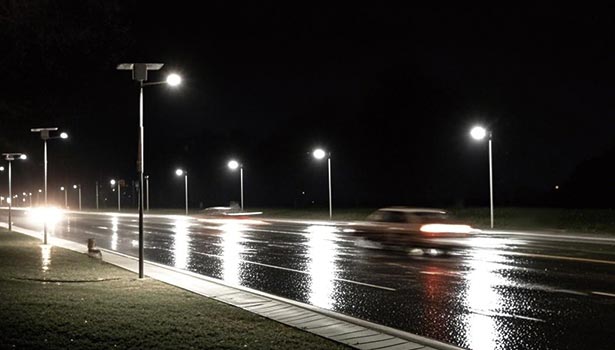
Low-Light and High-Efficiency Power Generation
In the rainy season when light is insufficient, NOKIN's solar panels have “special skills”:
High-efficiency conversion: using mono/polycrystalline high-conversion-efficiency panels, the solar panels are able to maintain power generation efficiency of more than 15% on cloudy and rainy days when the light intensity is only 20% of that of a sunny day.
Anti-shading design: the panel surface is hydrophobic, so rainwater can quickly slide off, reducing the efficiency loss caused by falling leaves, bird droppings and other shading.
Intelligent energy replenishment: Equipped with large-capacity energy storage battery (supporting 3-5 days of rainy and cloudy life), the electricity stored in sunny days can be continuously released in rainy days to ensure that the lighting is constantly powered.
Intelligent Adjustment System
NOKIN's “Intelligent Brain” makes the street light understand the needs of the rainy season better:
Light Sensor Linkage: Built-in light sensor automatically recognizes cloudy and rainy days, and intelligently switches to energy-saving modes - the brightness is lowered by 30%, but the range is extended by 50%, guaranteeing all-night illumination. The light sensor automatically recognizes rainy days and intelligently switches energy-saving modes - reducing brightness by 30% but extending life by 50%.
Dynamic management: Real-time monitoring of power consumption through the battery BMS system, avoiding overcharging and over-discharging and extending battery life by more than 20%.
Failure Alert: Supports remote monitoring, and automatically pushes maintenance reminders if it detects abnormal waterproof sealing or a sudden drop in power generation, which reduces the cost of manual inspection.
Detailed Design to Enhance Long-Term Reliability
Tilt angle optimization: The tilt angle of the solar panel is scientifically designed (15°-30°) to accelerate the sliding down of rainwater and reduce the accumulation of dust to enhance the cleaning efficiency.
Anti-corrosion treatment: Metal parts are painted to prevent rust, and optional stainless steel modules are available for coastal areas to resist salt spray.
Easy maintenance structure: modular design supports quick disassembly, so you can quickly check the lines and replace the components during the rainy season maintenance to reduce the downtime.
Multi-Scenario Adaptation
Whether it is a city trunk road, countryside road, coastal typhoon area or mountainous rainy area, NOKIN has a targeted program:
Regular rainy area: the basic model meets the lighting of 3-5 consecutive days of rainy and cloudy, and the IP65 protection can cope with daily rainfall.
Stormy and high-frequency areas: Upgraded IP66 model with strengthened waterproof structure and larger capacity battery to cope with extreme weather.
Hybrid energy solution: optional wind energy complementary system, wind power generation to make up energy when there is no light, suitable for rainy areas where light is scarce.
Maintenance Tips for Rainy Season
Regular Cleaning of Solar Panels
Frequency: 1 time per month, 1 time per two weeks in sandy and dusty areas;
Methods: Wipe with a soft cloth dipped in a neutral detergent (e.g., dishwashing detergent water), and avoid the use of abrasive materials such as steel wire balls;
Focus: Remove bird droppings, leaves and other obstructions, and experiments have shown that power generation of cleaned solar panels can be enhanced by 15%-20%.
Battery Status Fine Management
Lead-acid batteries: check the electrolyte level every quarter, add distilled water when it is lower than the scale line; use baking soda solution to clean the terminals to prevent oxidation;
Lithium batteries: avoid exposure to sunlight, ensure that the installation location is ventilated to dissipate heat, and use a multimeter to check the voltage balance of the battery cell every six months.
Wiring and Sealing Maintenance
Wiring inspection: check whether the wiring joints are loose and oxidized every month, use waterproof tape to reinforce the exposed wires;
Sealing test: observe whether there are water droplets inside the lamp body after rain, if so, replace the aging adhesive strip and apply waterproof sealant if necessary.
Structural Stability Maintenance
Reinforcement of light poles: tighten the base bolts every year, and spray anti-rust paint after sanding the rusted parts;
Panel Angle Adjustment: fine-tune the inclination angle of solar panels according to seasonal changes, and appropriately increase the inclination angle (e.g., adjust it from 20° to 25°) during rainy seasons, so as to reduce the accumulation of dust and rainwater retention.
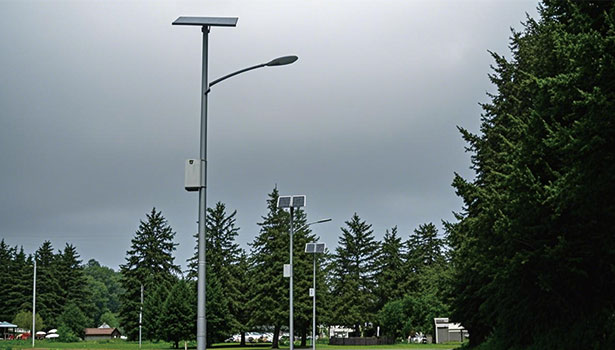
Conclusion
The test of rainy season environment on solar street light is a comprehensive competition of “waterproof performance + energy management + reliability design”. Choosing products with IP65 or above waterproof rating, high-efficiency solar panels and high-capacity lithium batteries, together with scientific maintenance, can completely realize stable lighting in rainy season.
Click to buy NOKIN rainy season solar street lights and enjoy free waterproof performance test; Through professional selection and maintenance, solar street light can still be a reliable guardian of light in the rainy season.

